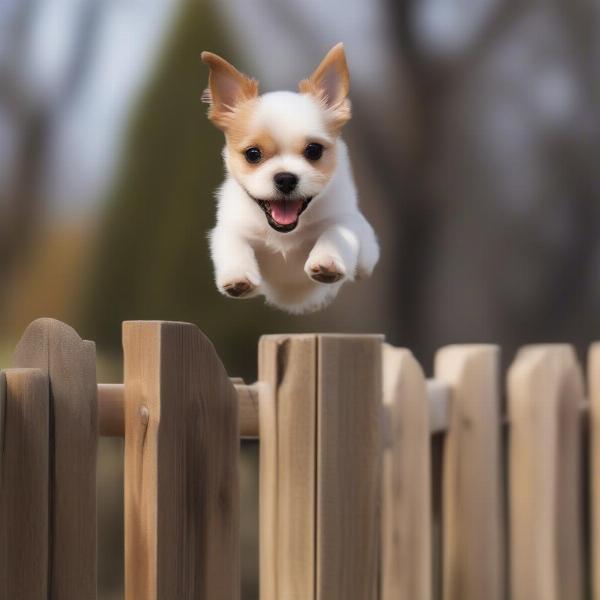Keeping your dog safely contained within your yard is a top priority for any responsible pet owner. A jumping dog can be a real headache, posing risks to both the dog and the community. If you’re struggling with a canine escape artist, this article will provide you with practical strategies and effective solutions on how to keep your dog from jumping over the fence.
Understanding Why Dogs Jump Fences
Before tackling the problem, it’s crucial to understand the root causes of your dog’s jumping behavior. Is it boredom, anxiety, a territorial instinct, or perhaps they’ve spotted something interesting on the other side? Some breeds are naturally more prone to jumping, particularly athletic breeds like Huskies or Greyhounds. Identifying the underlying motivation will guide you towards the most effective solution. For example, a bored dog might benefit from increased exercise and mental stimulation, while an anxious dog might require behavioral modification techniques.
Practical Solutions to Prevent Fence Jumping
Several practical measures can be implemented to deter your dog from scaling your fence. One of the first things to consider is the height and design of your fence. Is it tall enough for your dog’s breed and jumping ability? A solid fence can be more effective than a see-through one, as it eliminates visual temptations.
 Dog jumping over a low fence
Dog jumping over a low fence
Consider installing coyote rollers, which are rotating cylinders placed atop the fence, making it difficult for dogs to gain a foothold. Alternatively, leaning panels inwards at a 45-degree angle can also prevent climbing and jumping.
Training and Behavioral Modification
Training plays a vital role in curbing fence jumping. Teaching your dog basic obedience commands like “stay,” “come,” and “leave it” can be incredibly helpful. Positive reinforcement training, using rewards and praise, is often the most effective method. Consistency is key – practice these commands regularly, both inside and outside the house, especially near the fence.
For dogs motivated by anxiety or territoriality, consider consulting a certified dog trainer or behaviorist. They can help identify specific triggers and develop a tailored training plan.
Creating a Stimulating Environment
A bored dog is more likely to seek out entertainment, which might include escaping your yard. Ensure your dog receives adequate physical exercise through daily walks, playtime, and interactive games. Mental stimulation is equally important. Provide puzzle toys, engage in training sessions, and offer opportunities for social interaction with other dogs or people.
Will a Second Dog Help?
While getting another dog might seem like a solution to alleviate boredom or separation anxiety, it’s not a guaranteed fix for fence jumping. In some cases, it might even exacerbate the problem, especially if the new dog is also a jumper. Carefully consider your dog’s personality and the potential dynamics before introducing another pet.
how to stop a dog from climbing a fence
Securing Vulnerable Areas
Inspect your fence regularly for any weaknesses or gaps that your dog could exploit. Reinforce weak spots and ensure gates are securely latched. Consider adding a layer of chicken wire or mesh along the bottom of the fence to prevent digging.
Distraction Techniques
If your dog tends to jump when triggered by passersby or other animals, create visual barriers like bushes or shrubs along the fence line to minimize distractions. Providing a designated “watch zone” with a clear view can also satisfy their curiosity.
Conclusion
Addressing fence jumping requires a multifaceted approach. By understanding your dog’s motivation, implementing practical deterrents, and providing a stimulating environment, you can effectively keep your dog safely contained and enjoy peace of mind. Remember, consistency and patience are crucial for success.
enclosed porch that dogs can't get out
FAQ
-
My dog only jumps when I’m not home. What can I do? Consider using a dog camera to monitor their behavior and identify triggers. You can also try leaving them with interactive toys or puzzle feeders to keep them occupied.
-
Is it cruel to use coyote rollers? Coyote rollers are designed to deter, not harm. They rotate when a dog attempts to climb, preventing them from gaining purchase. They are generally considered a humane deterrent.
-
How tall should my fence be? The ideal fence height depends on your dog’s breed and jumping ability. For most dogs, a 6-foot fence is sufficient.
-
What if my dog continues to jump despite my efforts? Consult a professional dog trainer or behaviorist for personalized guidance.
-
Can I use an invisible fence to prevent jumping? While invisible fences can contain some dogs, they don’t physically prevent jumping. A determined dog can still jump the fence and receive a shock upon returning.
-
Are there any breeds that are more prone to jumping? Athletic breeds like Huskies, Greyhounds, and German Shepherds are often more prone to jumping.
-
How can I make my yard more stimulating for my dog? Provide puzzle toys, engage in regular training sessions, create a digging pit, and offer opportunities for social interaction.
will getting another dog help with separation anxiety
ILM Dog is your trusted resource for comprehensive dog care information, offering expert advice on breeds, health, training, nutrition, grooming, and much more. From puppyhood to senior care, we provide practical solutions and valuable insights to help you navigate every stage of your dog’s life. Contact us today to learn more about our services and how we can help you and your furry friend. Email: [email protected], Phone: +44 20-3965-8624. ILM Dog is committed to providing the best resources for your canine companion.